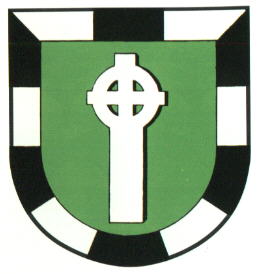Einhaus: Difference between revisions
Knorrepoes (talk | contribs) No edit summary |
Knorrepoes (talk | contribs) m (Text replace - "[[Literature" to "{{media}} [[Literature") |
||
| Line 22: | Line 22: | ||
The cross in the arms is derived from a late Gothic memorial stone in the village. On the spot of the cross St. Ansverus supposedly died as a martyr in 1066. The memorial itself dates probably from the late 14<sup>th</sup> century.<br/> | The cross in the arms is derived from a late Gothic memorial stone in the village. On the spot of the cross St. Ansverus supposedly died as a martyr in 1066. The memorial itself dates probably from the late 14<sup>th</sup> century.<br/> | ||
The bordure is derived from the arms of the Duchy of Lauenburg, to which the area belonged (see the district arms). | The bordure is derived from the arms of the Duchy of Lauenburg, to which the area belonged (see the district arms). | ||
{{media}} | |||
[[Literature]] : Reissmann, 1998. | [[Literature]] : Reissmann, 1998. | ||
Revision as of 21:07, 8 July 2014
| Heraldry of the World Civic heraldry of Germany - Deutsche Wappen (Gemeindewappen/Kreiswappen) |
EINHAUS
State : Schleswig-Holstein
District (Kreis) : Herzogtum Lauenburg
Amt : Amt Lauenburgische Seen
Official blazon
In Grün mit von Silber und Schwarz zwölfmal gestücktem Bord eine silberne Stele, die oben in einem Radkreuz mit oben und seitlich überstehenden Balken endent.
Origin/meaning
The arms were granted on June 15, 1979.
The cross in the arms is derived from a late Gothic memorial stone in the village. On the spot of the cross St. Ansverus supposedly died as a martyr in 1066. The memorial itself dates probably from the late 14th century.
The bordure is derived from the arms of the Duchy of Lauenburg, to which the area belonged (see the district arms).
Contact and Support
Partners:
Your logo here ?
Contact us
© since 1995, Heraldry of the World, Ralf Hartemink 
Index of the site
Literature : Reissmann, 1998.











